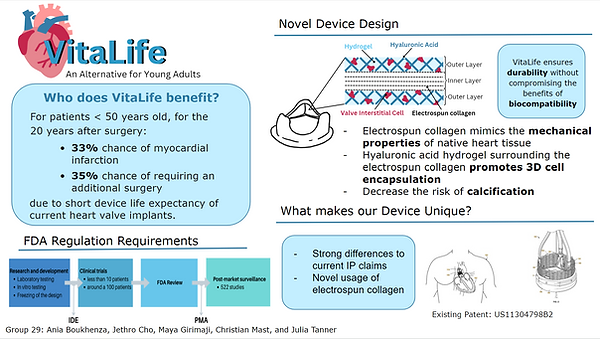Master of Engineering in
Mechanical Engineering (Biomechanics)
I am proud to be an alumni of the Coleman Fung Institute for Engineering Leadership. This program stood out to me because its emphasis on a well-rounded education in order to be a successful engineer. While Berkeley provides outstanding technical curriculum and impressive faculty, the M.Eng Program also provides education on business concepts, communication tactics, and other skills essential to being a successful engineer. This will help me create medical devices that have novice technical features and are able to successfully reach the market.
Specialization in Biomechanics
As a continuation of my undergraduate studies, I wanted to further my knowledge on medical device development. Now that I have a background in mechanical engineering concepts, I can further specialize my degree and focus on engineering innovations in the healthcare industry.
Advanced Augmented Human Dexterity
Disabilities are classified as conditions that inhibit individuals from performing tasks due to societal barriers. While is it common for devices to be created for people with disabilities, it is also important to remember as engineers to create inclusive designs in every project we pursue. However, because creating accessible technology for everyone is a daunting task, assistive devices and technology are still required. Topics in this class were paired with hands-on labs to explore mechantronics concepts and the design process for wearable devices. Additionally, I completed a group project titled "Fieldwork Orthosis", which can be seen here.
For more information on the teaching team, class projects, and my projects technical report, check out the class website!
Robotic Locomotion
This course provides students with a basic understanding of robotic locomotion and the use of kinematics, dynamics, control algorithms, embedded microcomputers and mechanical components in designing artificial legs such as prosthetics, orthotics and exoskeletons. I wanted to expand my knowledge on robotics and how to apply my previous biomechanics knowledge to robotic systems. Assignments explored how to define trajectory equations can be used to control robotic arms and powered prosthetic legs. The final project of the class was focused on creating a dampening knee brace to decrease impact experienced by the knee and decrease patellar tendon injury. However, my group was unable to validate a design concept that utilized a passive mechanism to create dampening within the time frame of the class.

The graph above shows the vertical displacement of two different points on the foot during gait cycle. The positions were predicted using relative angle displacement of the hip, knee, and ankle during gait. Since angle data was localized, rotational and translational transformation matrixes were used to define the global coordinates of the two points on the foot during gait.
Advanced Orthopedics
This class explored topics of musculoskeletal biomechanics and implant design. With my previous background in anatomy and biomechanics, I was interested in the class projects focused on analyzing implant design. MatLab was used to analyze stress within a bone and implant system under static and dynamic circumstances. As a graduate student, I conducted my own research paper with numerical analysis to understand the effects of wrist position during a backhand stroke on elbow stress in tennis players. The findings shows that keeping a neutral wrist position during a backhand stroke caused the highest stress in extensor muscles, which could lead to tennis elbow (lateral epicondylitis). However, since the numerical analysis was simplified for the purpose of the paper, additional computational models are needed to fully understand the biomechanics of a backhand stroke.

The image above shows a MatLab stress analysis of a femur cross section without a bone implant. The bone was exposed to an external moment and applied at the hip to simulate walking or common daily activities. The bone was assumed to be heterogeneous and a young's modulus that was common for younger patients. This stress composition was compared to stress analysis of implants positioned at four different locations to determine which implant location would minimize long term issues.
Advanced Structural Aspects of Biomaterials
Biocompatibility is a crucial design consideration when creating medical devices. This class provided an overview of biomaterials, an analysis of commonly used materials in commercially available medical devices, guest speakers from industry partners, and case study analyses to understand the shortcomings of current technology.

In addition to participating in class, there were three group projects throughout the semester. All three projects focused on different aspects of creating a medical device with an overarching theme. My group focused on cardiac related medical devices, specifically the aortic heart valve implant. All three projects required a technical report, three minute presentation, and a slide to visualize findings. The first project summarized the history of heart valve innovation. The second project analyzed the common material and clinical failure mechanisms. The final project consisted of a novice product proposal with a market and IP analysis. The slide shown is the summarizing slide for project three.
Other Engineering Courses
-
Organizational Behavior and Negotiations (ENGIN 270A)
-
R&D Technology Management & Ethics (ENGIN 270B)
-
Teaming and Project Management (ENGIN 270C)
-
Communications for Engineering Leaders (ENGIN 295)
-
Innovation Management (ENGIN 270N)
-
Power of Persuasion (ENGIN 270P)